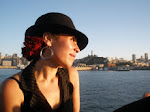In Origenes de Vuelo/Origins of Flight: An Immigration Story, David Herrera tells the story of his mother's youthful journey from Mexico to the U.S.
The dance begins and ends with strong solo dance by Evan Hart Marsh, framing the narrative within the perspective of the son of the immigrant. In the first scene, there is no music, but a voice-over reminiscent of the stale voice of automated messages. On either side of the stage hang two large screens, made up of various pieces of white towels and clothing, upon which play scenes from the San Francisco Mission district.This is the world that the son of an immigrant inhabits: a world between languages and cultures, the experience from which Herrera tries to tell his mother's story.
It is a fascinating story even in its commonness: a young woman, 22 years old and pregnant, makes her way from her small town in Mexico to the U.S. and must navigate the perils of the road. The story itself is rife with material for a dynamic performance, however, the choreography was littered with literal, trite movements that were often over performed and the narrative somehow got lost in the progression of the performance.
Mia Aiko Yamada, playing the part of the immigrant mother, executed her dances spectacularly, having both the technical foundation and compassion necessary to make emotive dance.
The music and the images that played upon the laundry-like screens were reprivals for the weak dancing, providing more dimensions to the performance. Shimomitsu, a music collaborative, created the score specifically for this show, and the music represented the duality of the piece--the struggle to know and understand each culture individually and to blend them seamlessly. Olivia Ting created the background images, working to create an "emotional landscape" for each dance. She layered images and played with movement and repetition and timing to create a viable background for the dance.
None of the dancers are immigrants, and they needed to find ways to connect to the piece. "As dancers, that--emotion--is all we have to give," commented Herrera in the post-performance discussion. In light of this, he concentrated his efforts on getting his dancers to connect to the piece emotionally. Choreographing the piece was a community process, with Herrera giving a fundamental choreography and then giving the dancers room to add to and change it as they saw fit. Marsh spoke of connecting to the piece through this process. "It was how I connected with the story--David tells the story and then we make it our own...I am close with my mother, so the duet was really powerful for me," Hart said. "Initially, I was connected to the giving, learning process but at the end, in her [the mother's] arrival, I understood." If only the audience was carried along in this journey as well--the performance had so much going for it, but it seemed as if it could have used more time in production.
Saturday, November 14, 2009
Dance Narrative: An Immigration Story
Subscribe to:
Post Comments (Atom)

No comments:
Post a Comment